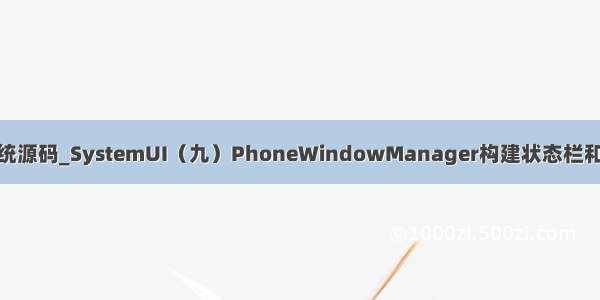
目录
目录
1.推荐博客:
2.控制是否显示属性:qemu.hw.mainkeys
3.调整大小:system/bigsystem/device/hisilicon/Hi3798MV200/overlay/frameworks/base/core/res/res/values/dimens.xml
4.android6.0 TV 添加自定义导航栏
5. 修改导航栏的背景色
6.隐藏状态栏
1.推荐博客:
Android之SystemUI载入流程和NavigationBar的分析 - liguangsunls - 博客园
android6.0 TV 添加自定义导航栏_storm_peng的专栏-CSDN博客
android6.0 TV 添加自定义导航栏 -
2.控制是否显示属性:qemu.hw.mainkeys
3.调整大小:system/bigsystem/device/hisilicon/Hi3798MV200/overlay/frameworks/base/core/res/res/values/dimens.xml
4.android6.0 TV 添加自定义导航栏
Android TV 通常是用遥控器操作的,系统导航栏都是关闭的,但带触摸的TV就很有必要加上导航栏了。
1. 修改base/core/res/res/values/config.xml
base/core/res/res/values/config.xml- <bool name="config_showNavigationBar">false</bool>+ <bool name="config_showNavigationBar">true</bool>
但是在TV 上屏通常是横屏的,手机上是竖屏的,仅仅打开上面这个设置,在TV 右边屏幕就会有一个黑条的导航栏,但没有图标,这时候就要把导航栏想办法改到屏幕下面,
2. base/services/core/java/com/android/server/policy/PhoneWindowManager.java
mNavigationBarOnBottom这个值决定导航条的位置,从名字就看的出来,true 的时候是底部,false在垂直右边,在TV 屏的1920x1080分辨率上这个值 为false,所以直接改为true
主要代码在setInitialDisplaySize, 和beginLayoutLw这两个函数里,包括导航栏的位置,其实X,Y 坐标,长宽等到
public voidsetInitialDisplaySize(Display display, int width, int height, int density) {
......................................
mNavigationBarCanMove = width != height && shortSizeDp < 600;这个值在setInitialDisplaySize函数里
........................................
public voidbeginLayoutLw(boolean isDefaultDisplay, int displayWidth, int displayHeight,
int displayRotation) {
mNavigationBarOnBottom =true;//(!mNavigationBarCanMove || displayWidth < displayHeight);
if (mNavigationBarOnBottom) {
// It's a system nav bar or a portrait screen; nav bar goes on bottom.
inttop= displayHeight - overscanBottom//计算底部显示的 Y 坐标
- 100;//mNavigationBarHeightForRotation[displayRotation];这个值是导航栏的宽度,在setInitialDisplaySize计算出来是0,
实际Y 坐标top就是1080了,这 样看不到了导航栏了,这里直接改成100
mTmpNavigationFrame.set(0, top, displayWidth, displayHeight - overscanBottom);//设置导航栏位置大小
................................
} else {
// Landscape screen; nav bar goes to the right.
intleft= displayWidth - overscanRight//计算在右边显示 X 坐标
- mNavigationBarWidthForRotation[displayRotation];
mTmpNavigationFrame.set(left, 0, displayWidth - overscanRight, displayHeight);
................................
这样导航栏的三个图标就出来了
3. 修改base/packages/SystemUI/res/layout/navigation_bar.xml 实现自定义布局
在base/packages/SystemUI/src/com/android/systemui/statusbar/phone/NavigationBarView.java 文件的函数
public void onFinishInflate() {
mRotatedViews[Surface.ROTATION_0] =mRotatedViews[Surface.ROTATION_180] = findViewById(R.id.rot0);
mRotatedViews[Surface.ROTATION_90] = findViewById(R.id.rot90);
mRotatedViews[Surface.ROTATION_270] = mRotatedViews[Surface.ROTATION_90];
mCurrentView = mRotatedViews[Surface.ROTATION_0];TV 实际用的这个,所以布局里就只修改
}
注意:原来的返回,主页,任务的三个图标,代码里面还会引用图片的名字。如果要替换,最好把要换的图片名字改成原来的一样,直接覆盖替换,否则代码里还要同步修改。
4. 修改按钮事件
layout 文件里每个KeyButtonView下有一个systemui:keyCode="4",对应按键映射码,最终会在KeyButtonView 里取出来赋值给mCode = a.getInteger(R.styleable.KeyButtonView_keyCode, 0); 在sendEvent 里虚拟一个按键事件把这个按键发送出去。对于其他新增加的按钮事件,可以找一个没用到的按键当作该按钮的按键,比如定义为KEYCODE_F1, 在navigation_bar.xml 里修改systemui:keyCode="131",再在PhoneWindow.java 的onKeyDown里添加下面代码,就可以在任何界面都能打开该activity了
case KeyEvent.KEYCODE_F1: {Intent itent = new Intent();itent.setClassName("com.supera.board", "com.supera.board.MainActivity");mContext.startActivity(itent);return true;}
最终的自定义导航栏就如下面的效果
5. 修改导航栏的背景色
在navigation_bar.xml 里有 android:background="@drawable/system_bar_background" 这一行,实际光修改这里是不起作用的,参考/kongbaidepao/article/details/82118406这篇文章,屏蔽掉一行
再修改 android:background="@drawable/system_bar_background" 就可以自定义背景颜色了
6. 修改导航栏的动态隐藏显示
参考/way_ping_li/article/details/45727335修改后,隐藏没有问题,但手势滑不出来导航栏,经过查找发现SystemGesturesPointerEventListener.java 文件里的screenWidth ,screenHeight ,mSwipeStartThreshold 这是三个值都是0,导致在下面函数返回SWIPE_NONE
添加如下一段代码功能就正常手势滑开了
public SystemGesturesPointerEventListener(Context context, Callbacks callbacks) {..................WindowManager wm = (WindowManager)context.getSystemService(Context.WINDOW_SERVICE); screenWidth = wm.getDefaultDisplay().getWidth(); screenHeight = wm.getDefaultDisplay().getHeight(); mSwipeStartThreshold = 20;//checkNull("context", context).getResources()................
6.隐藏状态栏
frameworks/base/core/res/res/values/dimens.xml
将高度 24 改成 0 android 11上此方法只会隐藏顶部那部分UI,想要隐藏下拉的状态栏,还需要改动java代码如下:
framework/base/packages/SystemUI/src/android/systemui/statusbar/phone/StatusBar.java
makeStatusBarView函数设置mStatusBarView.setVisibility(View.GONE);
// ================================================================================// Constructing the view// ================================================================================protected void makeStatusBarView(@Nullable RegisterStatusBarResult result) {final Context context = mContext;updateDisplaySize(); // populates mDisplayMetricsupdateResources();updateTheme();inflateStatusBarWindow();mNotificationShadeWindowViewController.setService(this, mNotificationShadeWindowController);mNotificationShadeWindowView.setOnTouchListener(getStatusBarWindowTouchListener());// TODO: Deal with the ugliness that comes from having some of the statusbar broken out// into fragments, but the rest here, it leaves some awkward lifecycle and whatnot.mStackScroller = mNotificationShadeWindowView.findViewById(R.id.notification_stack_scroller);NotificationListContainer notifListContainer = (NotificationListContainer) mStackScroller;mNotificationLogger.setUpWithContainer(notifListContainer);// TODO: make this injectable. Currently that would create a circular dependency between// NotificationIconAreaController and StatusBar.mNotificationIconAreaController = SystemUIFactory.getInstance().createNotificationIconAreaController(context, this,mWakeUpCoordinator, mKeyguardBypassController,mStatusBarStateController);mWakeUpCoordinator.setIconAreaController(mNotificationIconAreaController);inflateShelf();mNotificationIconAreaController.setupShelf(mNotificationShelf);mNotificationPanelViewController.setOnReinflationListener(mNotificationIconAreaController::initAodIcons);mNotificationPanelViewController.addExpansionListener(mWakeUpCoordinator);mDarkIconDispatcher.addDarkReceiver(mNotificationIconAreaController);// Allow plugins to reference DarkIconDispatcher and StatusBarStateControllermPluginDependencyProvider.allowPluginDependency(DarkIconDispatcher.class);mPluginDependencyProvider.allowPluginDependency(StatusBarStateController.class);FragmentHostManager.get(mPhoneStatusBarWindow).addTagListener(CollapsedStatusBarFragment.TAG, (tag, fragment) -> {CollapsedStatusBarFragment statusBarFragment =(CollapsedStatusBarFragment) fragment;PhoneStatusBarView oldStatusBarView = mStatusBarView;mStatusBarView = (PhoneStatusBarView) statusBarFragment.getView();mStatusBarView.setBar(this);mStatusBarView.setVisibility(View.GONE);mStatusBarView.setPanel(mNotificationPanelViewController);mStatusBarView.setScrimController(mScrimController);statusBarFragment.initNotificationIconArea(mNotificationIconAreaController);// CollapsedStatusBarFragment re-inflated PhoneStatusBarView and both of// mStatusBarView.mExpanded and mStatusBarView.mBouncerShowing are false.// PhoneStatusBarView's new instance will set to be gone in// PanelBar.updateVisibility after calling mStatusBarView.setBouncerShowing// that will trigger PanelBar.updateVisibility. If there is a heads up showing,// it needs to notify PhoneStatusBarView's new instance to update the correct// status by calling mNotificationPanel.notifyBarPanelExpansionChanged().if (mHeadsUpManager.hasPinnedHeadsUp()) {mNotificationPanelViewController.notifyBarPanelExpansionChanged();}mStatusBarView.setBouncerShowing(mBouncerShowing);if (oldStatusBarView != null) {float fraction = oldStatusBarView.getExpansionFraction();boolean expanded = oldStatusBarView.isExpanded();mStatusBarView.panelExpansionChanged(fraction, expanded);}HeadsUpAppearanceController oldController = mHeadsUpAppearanceController;if (mHeadsUpAppearanceController != null) {// This view is being recreated, let's destroy the old onemHeadsUpAppearanceController.destroy();}// TODO: this should probably be scoped to the StatusBarComponent// TODO (b/136993073) Separate notification shade and status barmHeadsUpAppearanceController = new HeadsUpAppearanceController(mNotificationIconAreaController, mHeadsUpManager,mNotificationShadeWindowView,mStatusBarStateController, mKeyguardBypassController,mKeyguardStateController, mWakeUpCoordinator, mCommandQueue,mNotificationPanelViewController, mStatusBarView);mHeadsUpAppearanceController.readFrom(oldController);mLightsOutNotifController.setLightsOutNotifView(mStatusBarView.findViewById(R.id.notification_lights_out));mNotificationShadeWindowViewController.setStatusBarView(mStatusBarView);checkBarModes();}).getFragmentManager().beginTransaction().replace(R.id.status_bar_container, new CollapsedStatusBarFragment(),CollapsedStatusBarFragment.TAG).commit();mHeadsUpManager.setup(mVisualStabilityManager);mStatusBarTouchableRegionManager.setup(this, mNotificationShadeWindowView);mHeadsUpManager.addListener(this);mHeadsUpManager.addListener(mNotificationPanelViewController.getOnHeadsUpChangedListener());mHeadsUpManager.addListener(mVisualStabilityManager);mNotificationPanelViewController.setHeadsUpManager(mHeadsUpManager);mNotificationLogger.setHeadsUpManager(mHeadsUpManager);createNavigationBar(result);if (ENABLE_LOCKSCREEN_WALLPAPER && mWallpaperSupported) {mLockscreenWallpaper = mLockscreenWallpaperLazy.get();}mKeyguardIndicationController.setIndicationArea(mNotificationShadeWindowView.findViewById(R.id.keyguard_indication_area));mNotificationPanelViewController.setKeyguardIndicationController(mKeyguardIndicationController);mAmbientIndicationContainer = mNotificationShadeWindowView.findViewById(R.id.ambient_indication_container);// TODO: Find better place for this callback.mBatteryController.addCallback(new BatteryStateChangeCallback() {@Overridepublic void onPowerSaveChanged(boolean isPowerSave) {mHandler.post(mCheckBarModes);if (mDozeServiceHost != null) {mDozeServiceHost.firePowerSaveChanged(isPowerSave);}}@Overridepublic void onBatteryLevelChanged(int level, boolean pluggedIn, boolean charging) {// noop}});mAutoHideController.setStatusBar(new AutoHideUiElement() {@Overridepublic void synchronizeState() {checkBarModes();}@Overridepublic boolean shouldHideOnTouch() {return !mRemoteInputManager.getController().isRemoteInputActive();}@Overridepublic boolean isVisible() {return isTransientShown();}@Overridepublic void hide() {clearTransient();}});ScrimView scrimBehind = mNotificationShadeWindowView.findViewById(R.id.scrim_behind);ScrimView scrimInFront = mNotificationShadeWindowView.findViewById(R.id.scrim_in_front);ScrimView scrimForBubble = mBubbleController.getScrimForBubble();mScrimController.setScrimVisibleListener(scrimsVisible -> {mNotificationShadeWindowController.setScrimsVisibility(scrimsVisible);if (mNotificationShadeWindowView != null) {mLockscreenLockIconController.onScrimVisibilityChanged(scrimsVisible);}});mScrimController.attachViews(scrimBehind, scrimInFront, scrimForBubble);mNotificationPanelViewController.initDependencies(this, mGroupManager, mNotificationShelf,mNotificationIconAreaController, mScrimController);BackDropView backdrop = mNotificationShadeWindowView.findViewById(R.id.backdrop);mMediaManager.setup(backdrop, backdrop.findViewById(R.id.backdrop_front),backdrop.findViewById(R.id.backdrop_back), mScrimController, mLockscreenWallpaper);float maxWallpaperZoom = mContext.getResources().getFloat(com.android.internal.R.dimen.config_wallpaperMaxScale);mNotificationShadeDepthControllerLazy.get().addListener(depth -> {float scale = MathUtils.lerp(maxWallpaperZoom, 1f, depth);backdrop.setPivotX(backdrop.getWidth() / 2f);backdrop.setPivotY(backdrop.getHeight() / 2f);backdrop.setScaleX(scale);backdrop.setScaleY(scale);});mNotificationPanelViewController.setUserSetupComplete(mUserSetup);if (UserManager.get(mContext).isUserSwitcherEnabled()) {createUserSwitcher();}mNotificationPanelViewController.setLaunchAffordanceListener(mLockscreenLockIconController::onShowingLaunchAffordanceChanged);// Set up the quick settings tile panelfinal View container = mNotificationShadeWindowView.findViewById(R.id.qs_frame);if (container != null) {FragmentHostManager fragmentHostManager = FragmentHostManager.get(container);ExtensionFragmentListener.attachExtensonToFragment(container, QS.TAG, R.id.qs_frame,mExtensionController.newExtension(QS.class).withPlugin(QS.class).withDefault(this::createDefaultQSFragment).build());mBrightnessMirrorController = new BrightnessMirrorController(mNotificationShadeWindowView,mNotificationPanelViewController,mNotificationShadeDepthControllerLazy.get(),(visible) -> {mBrightnessMirrorVisible = visible;updateScrimController();});fragmentHostManager.addTagListener(QS.TAG, (tag, f) -> {QS qs = (QS) f;if (qs instanceof QSFragment) {mQSPanel = ((QSFragment) qs).getQsPanel();mQSPanel.setBrightnessMirror(mBrightnessMirrorController);}});}mReportRejectedTouch = mNotificationShadeWindowView.findViewById(R.id.report_rejected_touch);if (mReportRejectedTouch != null) {updateReportRejectedTouchVisibility();mReportRejectedTouch.setOnClickListener(v -> {Uri session = mFalsingManager.reportRejectedTouch();if (session == null) { return; }StringWriter message = new StringWriter();message.write("Build info: ");message.write(SystemProperties.get("ro.build.description"));message.write("\nSerial number: ");message.write(SystemProperties.get("ro.serialno"));message.write("\n");PrintWriter falsingPw = new PrintWriter(message);FalsingLog.dump(falsingPw);falsingPw.flush();startActivityDismissingKeyguard(Intent.createChooser(new Intent(Intent.ACTION_SEND).setType("*/*").putExtra(Intent.EXTRA_SUBJECT, "Rejected touch report").putExtra(Intent.EXTRA_STREAM, session).putExtra(Intent.EXTRA_TEXT, message.toString()),"Share rejected touch report").addFlags(Intent.FLAG_ACTIVITY_NEW_TASK),true /* onlyProvisioned */, true /* dismissShade */);});}if (!mPowerManager.isScreenOn()) {mBroadcastReceiver.onReceive(mContext, new Intent(Intent.ACTION_SCREEN_OFF));}mGestureWakeLock = mPowerManager.newWakeLock(PowerManager.SCREEN_BRIGHT_WAKE_LOCK,"GestureWakeLock");mVibrator = mContext.getSystemService(Vibrator.class);int[] pattern = mContext.getResources().getIntArray(R.array.config_cameraLaunchGestureVibePattern);mCameraLaunchGestureVibePattern = new long[pattern.length];for (int i = 0; i < pattern.length; i++) {mCameraLaunchGestureVibePattern[i] = pattern[i];}// receive broadcastsregisterBroadcastReceiver();IntentFilter demoFilter = new IntentFilter();if (DEBUG_MEDIA_FAKE_ARTWORK) {demoFilter.addAction(ACTION_FAKE_ARTWORK);}demoFilter.addAction(ACTION_DEMO);context.registerReceiverAsUser(mDemoReceiver, UserHandle.ALL, demoFilter,android.Manifest.permission.DUMP, null);// listen for USER_SETUP_COMPLETE setting (per-user)mDeviceProvisionedController.addCallback(mUserSetupObserver);mUserSetupObserver.onUserSetupChanged();// disable profiling bars, since they overlap and clutter the output on app windowsThreadedRenderer.overrideProperty("disableProfileBars", "true");// Private API call to make the shadows look better for RecentsThreadedRenderer.overrideProperty("ambientRatio", String.valueOf(1.5f));}
7.调整图标大小
Android P 禁止SystemUI 下拉状态栏和通知栏_逆风飞翔-CSDN博客
/jydzm/article/details/88745335
















